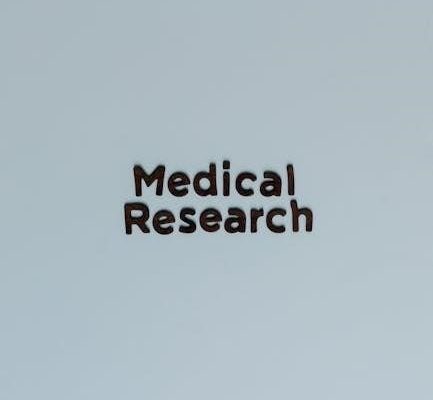Pharmacology is the study of drug interactions with biological systems, focusing on their therapeutic effects and safety. Study guides are essential resources for understanding pharmacokinetics, pharmacodynamics, and drug classifications, aiding students and healthcare professionals in mastering drug therapies and safe administration practices.
Definition and Scope of Pharmacology
Pharmacology is the scientific study of the interactions between drugs and biological systems, focusing on the mechanisms of drug action, therapeutic effects, and potential toxicity. It encompasses the discovery, development, and clinical application of medications. The scope of pharmacology includes understanding pharmacokinetics (absorption, distribution, metabolism, excretion) and pharmacodynamics (drug-receptor interactions). Study guides provide foundational knowledge, aiding students and professionals in grasping core principles, from drug classifications to advanced therapeutic strategies, ensuring safe and effective drug administration in clinical settings.
Importance of Pharmacology in Healthcare
Pharmacology plays a vital role in healthcare by enabling the safe and effective use of drugs to prevent, diagnose, and treat diseases. Understanding drug interactions, therapeutic effects, and potential toxicity ensures optimal patient outcomes. Pharmacology guides personalized treatment plans, reducing adverse reactions and improving quality of life. It also advances medical research, leading to the development of new therapies. Study guides and resources help healthcare professionals stay updated on pharmacological principles, ensuring evidence-based practices. By integrating pharmacology into clinical care, healthcare systems enhance patient safety and achieve better therapeutic results, making it a cornerstone of modern medicine.

Core Concepts in Pharmacology
Pharmacology focuses on drug absorption, distribution, metabolism, excretion, and mechanisms of action. It explores drug-receptor interactions and therapeutic effects, essential for safe and effective treatment.
Pharmacokinetics: Absorption, Distribution, Metabolism, and Excretion
Pharmacokinetics involves the study of drug movement through the body, encompassing absorption, distribution, metabolism, and excretion. Absorption examines how drugs enter systemic circulation, while distribution focuses on how they reach target tissues. Metabolism involves enzymatic processes that alter drug activity, primarily in the liver, and excretion covers how drugs are eliminated, typically through the kidneys or bile. Understanding these processes is crucial for determining dosing regimens and optimizing therapeutic outcomes.
Pharmacodynamics: Mechanisms of Drug Action
Pharmacodynamics explores how drugs interact with biological systems to produce effects. It involves drug-receptor interactions, where drugs bind to specific receptors, triggering responses; This can activate or inhibit cellular pathways, altering physiological functions. Factors like receptor affinity and drug concentration influence efficacy. Understanding pharmacodynamics helps predict therapeutic and adverse effects, guiding dose optimization and personalized treatment strategies.
Drug-Receptor Interactions
Drug-receptor interactions are fundamental to pharmacodynamics, where drugs bind to specific cellular receptors, triggering biological responses. Receptors are proteins embedded in cell membranes or intracellular structures. Drugs act as ligands, mimicking endogenous substances or inhibiting receptor function. Binding affinity and efficacy determine the drug’s effectiveness. Agonists activate receptors, while antagonists block their activation. This interaction modulates signaling pathways, influencing therapeutic and adverse effects. Understanding these mechanisms is crucial for drug development and personalized medicine, ensuring targeted therapies with minimal side effects;

Classification of Drugs
Drugs are classified by therapeutic use, chemical structure, or generic/trade names. This organization aids in understanding their mechanisms, dosages, and clinical applications, essential for effective treatment strategies.
Drugs by Therapeutic Use
Drugs are categorized by their therapeutic purpose, such as treating diseases, managing symptoms, or preventing conditions. Examples include anti-infectives, cardiovascular drugs, and analgesics. This classification helps in understanding their clinical applications, dosages, and potential interactions. Therapeutic use categorization is crucial for healthcare professionals to develop effective treatment plans and for patients to understand their medications better. It also aids in researching and comparing drugs with similar purposes, ensuring safe and targeted therapy. This approach simplifies the complex field of pharmacology, making it easier to study and apply in real-world scenarios.
Drugs by Chemical Structure
Drugs can be classified based on their chemical structure, which determines their pharmacological properties. This classification helps in understanding how drugs interact with biological systems. For example, beta-lactam antibiotics share a common structural feature, while statins have a similar chemical backbone. Studying drugs by their chemical structure aids in predicting their mechanisms of action, metabolism, and potential drug-drug interactions. Pharmacology study guides often emphasize this classification to help learners recognize patterns and similarities among drugs. This approach simplifies the study of complex drug molecules, making it easier to remember and apply in clinical practice.
Generic vs. Trade Names
Drugs are identified by both generic and trade names. Generic names are the official, scientific names based on the drug’s chemical structure, while trade names are brand-specific. For example, acetylsalicylic acid is the generic name for aspirin. Pharmacology study guides emphasize the importance of knowing both names for safe drug administration. Generic names are standardized, ensuring clarity in prescriptions, while trade names are used for marketing. Understanding this distinction is crucial for avoiding confusion and ensuring accurate drug identification in clinical practice. This classification is a fundamental concept in pharmacology, aiding healthcare professionals in prescribing and administering medications effectively.

Pharmacology Study Resources
Pharmacology study guides, templates, and PDF materials provide structured learning tools. They include detailed drug classifications, pharmacokinetics, and pharmacodynamics, aiding students in mastering complex concepts efficiently.
Pharmacology Study Guides and Templates
Pharmacology study guides and templates are designed to simplify complex concepts, offering structured learning tools. These resources include fillable PDFs, detailed drug classifications, and sections on pharmacokinetics and pharmacodynamics. They cater to various learning needs, from nursing students to graduate-level studies. Many guides feature self-assessment questions, exam preparation tips, and practical templates for drug calculation practice. Templates often cover therapeutic uses, generic and trade names, and drug-receptor interactions. These materials are invaluable for mastering pharmacological principles, ensuring a comprehensive understanding of drug actions and safe administration practices. They are widely recommended for both academic and clinical settings, enhancing study efficiency and knowledge retention.
Recommended Textbooks and PDF Materials
Key textbooks and PDF materials provide comprehensive insights into pharmacology, covering foundational principles and advanced concepts. Titles like Principles of Pharmacology ー Study Guide and Pharmacology and Clinical Pharmacology Handbook 2020 are widely recommended. These resources offer detailed explanations of pharmacokinetics, pharmacodynamics, and drug classifications. PDF materials often include self-assessment questions, case studies, and practical templates for drug calculation and administration. They are essential for students, nurses, and healthcare professionals, ensuring a thorough understanding of drug mechanisms and therapeutic applications. These materials are regularly updated to reflect current research and clinical practices, making them invaluable for both academic and professional use.
Online Courses and Tutorials
Online courses and tutorials offer flexible and interactive ways to study pharmacology. Platforms provide structured lessons, video lectures, and downloadable PDF materials. Resources like the British Pharmacological Society’s website and graduate-level courses such as PCL1002Y include tutorials on pharmacokinetics, drug-receptor interactions, and clinical applications. These tools cater to various learners, from students to healthcare professionals, ensuring a deep understanding of pharmacological principles. Many courses include self-assessment quizzes and case studies to reinforce learning, making them ideal for exam preparation and professional development. They are regularly updated to reflect the latest advancements in drug research and clinical practices.

Pharmacology Exam Preparation
Pharmacology study guides and PDF materials provide structured exam preparation, focusing on drug calculations, self-assessment questions, and safe medication practices to ensure mastery of pharmacological principles.
Drug Calculation and Pharmacology Exams
Drug calculation exams are critical for ensuring accurate medication administration. Pharmacology study guides, including fillable PDF templates, provide structured practice problems and formula sheets. These resources focus on key concepts like dosing, concentration, and administration routes, helping students master calculations. Self-assessment questions and answers are also included to reinforce learning. By utilizing these tools, healthcare professionals can improve their ability to safely and effectively administer medications, reducing errors in clinical settings. Regular practice with these materials is essential for building confidence and competence in pharmacological calculations.
Self-Assessment Questions and Answers
Self-assessment questions and answers are vital tools for reinforcing pharmacology concepts and preparing for exams. Many pharmacology study guides, including PDF formats, incorporate these resources to help learners evaluate their understanding; They cover topics like drug mechanisms, dosing, and side effects, providing immediate feedback. Interactive quizzes and case studies are often included to simulate real-world scenarios. These materials enable students to identify knowledge gaps and focus on areas needing improvement. Regular use of self-assessment tools enhances critical thinking and problem-solving skills, ensuring a strong foundation for clinical practice and exam success.
Exam Format and Study Tips
Pharmacology exams often include multiple-choice questions, case studies, and drug calculation problems. Study guides provide insights into exam formats, helping students prepare effectively. Tips include creating flashcards for key terms, focusing on high-yield topics, and practicing with sample questions. Active learning techniques, such as group discussions and self-quizzes, enhance retention. Timing practice exams helps manage time during actual tests. Understanding pharmacokinetics, pharmacodynamics, and drug classifications is crucial. Organized study schedules and prioritizing weak areas ensure comprehensive preparation. Utilizing online resources and review materials, like PDF guides, further supports exam success.

Advanced Topics in Pharmacology
Advanced pharmacology explores personalized medicine, pharmacogenomics, and emerging therapeutic targets, utilizing cutting-edge technologies to enhance drug development and improve treatment efficacy.
Clinical Pharmacology and Its Applications
Clinical pharmacology focuses on the practical application of drugs in patient care, optimizing therapeutic outcomes, and minimizing adverse effects. It involves understanding drug interactions, dosing regimens, and individual patient responses. Advanced topics include personalized medicine, where treatments are tailored based on genetic and physiological factors. Study guides and resources highlight the importance of pharmacogenomics, enabling healthcare providers to predict and prevent adverse drug reactions. Additionally, clinical pharmacology addresses emerging therapeutic targets and innovative drug delivery systems, enhancing treatment efficacy across various medical specialties. These applications underscore the critical role of pharmacology in modern healthcare, ensuring safe and effective drug use.
Pharmacology of Specific Drug Classes
Pharmacology of specific drug classes focuses on understanding how different categories of drugs interact with biological systems. For example, cardiovascular drugs target heart and blood vessel functions, while neurologic drugs affect the central nervous system. Study guides detail the mechanisms of action, therapeutic uses, and potential side effects of these drugs. They also highlight drug classifications, such as anti-inflammatory agents, antibiotics, and anticoagulants. Understanding these drug classes is crucial for tailoring treatments to patient needs and minimizing adverse reactions. Resources like PDF guides provide comprehensive insights, helping healthcare professionals master drug-specific knowledge for clinical applications.
Current Trends in Pharmacological Research
Current trends in pharmacological research emphasize personalized medicine, targeting specific molecular pathways to enhance drug efficacy and reduce side effects. Advances in pharmacogenomics enable tailored therapies based on genetic profiles. Emerging therapeutic targets include gene therapy, immunotherapy, and precision oncology. Artificial intelligence accelerates drug discovery, predicting molecular interactions and optimizing compounds. Biotechnology innovations, such as monoclonal antibodies, are revolutionizing treatment for chronic diseases. Researchers also focus on repurposing existing drugs for new indications. These advancements highlight the dynamic evolution of pharmacology, offering hope for improved patient outcomes. Study guides and PDF resources provide insights into these cutting-edge developments, aiding students and professionals in staying updated.

Pharmacology for Nurses and Healthcare Professionals
Nurses play a crucial role in drug administration, requiring deep understanding of pharmacokinetics, pharmacodynamics, and safe practices. Study guides provide essential insights for clinical decision-making and patient safety.
Nurses’ Responsibilities in Drug Administration

Nurses play a vital role in ensuring safe and effective drug administration. Their responsibilities include verifying prescriptions, administering drugs correctly, and monitoring patients for adverse reactions. They must adhere to the “six rights” of medication administration: right patient, right drug, right dose, right route, right time, and right documentation. Nurses also educate patients about their medications, potential side effects, and proper usage. They are responsible for maintaining accurate records and reporting any discrepancies or adverse events. Understanding pharmacokinetics and pharmacodynamics is crucial for nurses to optimize therapeutic outcomes and minimize risks. Regular updates on drug information and protocols ensure safe practice.
Safe Medication Practices
Safe medication practices are critical to preventing errors and ensuring patient safety. Nurses must use medication reconciliation to verify accuracy during transitions of care. Barcode scanning and electronic systems help confirm the right drug, dose, and patient. Double-checking medications before administration is essential to avoid mistakes; Patient education on proper drug use and side effects is vital. Reporting adverse drug events and near misses promotes a culture of safety. Staying updated on medication guidelines and new drugs ensures compliance with best practices. These strategies collectively minimize risks and enhance therapeutic outcomes, aligning with pharmacology study guide recommendations for safe drug administration.
Common Drugs in Clinical Settings
Clinical settings frequently use drugs like cardiac medications, antibiotics, analgesics, and antihypertensives. Cardiovascular drugs, such as beta-blockers and ACE inhibitors, manage heart conditions. Antibiotics like penicillin treat infections, while analgesics like acetaminophen relieve pain. Antihypertensives, including diuretics, control blood pressure. Anticoagulants, such as heparin, prevent clots, and antidiabetics like metformin manage glucose levels. Anesthetics and sedatives are used in surgeries, while bronchodilators like albuterol treat respiratory issues. These drugs are essential for patient care, and understanding their pharmacology through study guides ensures safe and effective administration, optimizing therapeutic outcomes in various clinical scenarios.

Pharmacology in Graduate Studies
Graduate pharmacology involves advanced courses like PCL1002Y, focusing on research methods and pharmacological principles. Study guides and PDF resources aid students in understanding drug mechanisms and clinical applications, enhancing their research capabilities and advanced understanding of pharmacology.
Graduate-Level Pharmacology Courses
Graduate-level pharmacology courses, such as PCL1002Y, focus on advanced pharmacological principles, including molecular mechanisms, biostatistics, and clinical applications. These courses emphasize research methodologies and critical analysis of drug interactions. Study guides and PDF materials provide in-depth insights into pharmacokinetics, pharmacodynamics, and therapeutic drug classes. Students explore specialized topics like neuropharmacology and oncology, developing expertise in drug development and personalized medicine. Practical exercises and case studies enhance understanding, preparing graduates for roles in research, academia, and clinical practice. These courses require a strong foundation in biochemistry and physiology, ensuring comprehensive training for future pharmacology professionals.
Research Methods in Pharmacology
Research in pharmacology involves systematic investigations of drug interactions with biological systems. Key methods include in vitro studies (e.g., cell cultures) and in vivo studies (animal and human trials). Pharmacokinetic and pharmacodynamic analyses are central, focusing on drug absorption, distribution, metabolism, and excretion, as well as therapeutic and adverse effects. Molecular biology techniques, such as receptor binding assays, and clinical trials are essential for drug discovery and development. Study guides and PDF resources provide detailed protocols and data interpretation strategies, aiding researchers in designing robust experiments and publishing findings. These methods ensure safe and effective drug therapies, advancing pharmacological knowledge and practice.
Pharmacological Principles for Graduate Students
Graduate-level pharmacology focuses on advanced concepts such as drug-receptor interactions and pharmacogenomics. Students explore how genetic variations influence drug responses, enabling personalized medicine. Principles of pharmacokinetics and pharmacodynamics are applied to understand drug behavior in the body. Study guides and PDF materials emphasize critical thinking and research methodologies, preparing students for independent investigations. These resources also cover emerging trends like targeted therapies and biologic drugs, ensuring a comprehensive understanding of modern pharmacology. Mastery of these principles is crucial for developing innovative treatments and advancing healthcare outcomes.

Future of Pharmacology
Personalized medicine and pharmacogenomics are transforming healthcare, enabling tailored drug therapies. Technological advances in drug development and AI-driven research are reshaping pharmacology’s future, improving treatment efficacy and safety.
Personalized Medicine and Pharmacogenomics
Personalized medicine tailors treatments to individual genetic profiles, enhancing efficacy and reducing side effects; Pharmacogenomics studies how genetic variations influence drug responses, enabling targeted therapies. This approach minimizes trial-and-error, improving patient outcomes and safety. Advances in genetic testing and data analysis are driving its adoption. Pharmacogenomics is revolutionizing healthcare by predicting drug effectiveness and toxicity, thus optimizing treatment plans. It’s a cornerstone of modern medicine, integrating genomics into clinical practice for better patient care.
Emerging Therapeutic Targets
Emerging therapeutic targets focus on precision medicine, identifying specific molecular pathways to treat diseases effectively. These targets include kinase inhibitors, monoclonal antibodies, and gene therapies, offering personalized treatment options. Advances in genomics and proteomics have accelerated their discovery, enabling drugs to act on precise cellular mechanisms. This approach reduces side effects and improves efficacy, particularly in chronic diseases like cancer and autoimmune disorders. Research continues to uncover new targets, driving innovation in drug development and patient care, ensuring tailored therapies for diverse conditions, enhancing treatment outcomes, and advancing medical science. These targets are reshaping pharmacology and clinical practice.
Technological Advances in Drug Development
Technological advances are revolutionizing drug development, enhancing precision and efficiency. Artificial intelligence accelerates the discovery of new compounds by analyzing vast datasets. Gene-editing tools like CRISPR enable targeted therapies, while 3D printing creates personalized medications. Advanced imaging and biomarkers improve clinical trial monitoring. These innovations streamline the development process, reduce costs, and improve drug safety. They also facilitate personalized medicine, tailoring treatments to individual patient needs. Such technologies are transforming pharmacology, ensuring faster and more effective drug development to address unmet medical needs and improve global health outcomes.



